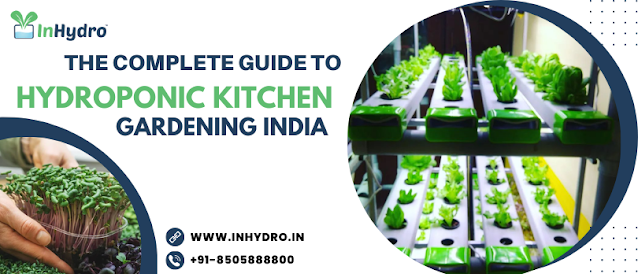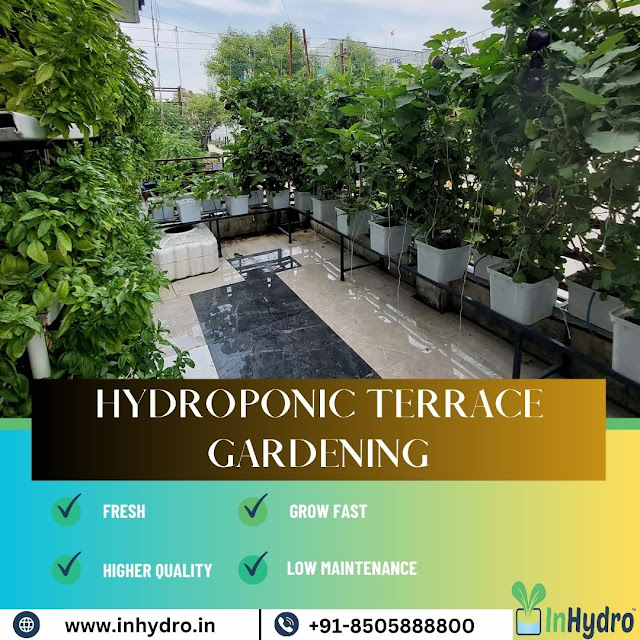The Complete Guide to Hydroponic Kitchen Gardening in India
Hydroponic kitchen gardening is a great way to grow your own fruits, vegetables, and herbs in your home. With the help of Inhydro, you can easily create a hydroponic garden in your kitchen and start growing your own produce! This complete guide to hydroponic kitchen gardening in India will walk you through everything you need to know to get started, including the supplies, techniques, and tips for success.
Introduction to hydroponics
Hydroponics is a method of growing plants without soil. It involves the use of nutrient-rich water instead of soil to provide the necessary minerals and nutrients for a healthy and abundant crop. Hydroponic gardening is becoming increasingly popular in India, especially for urban dwellers who lack space or access to traditional farming methods. Hydroponic home setups are relatively easy to build and manage, allowing anyone to produce their own fresh fruits, vegetables, and herbs. Additionally, hydroponic systems can be used to create larger-scale farms on rooftops or in backyards.
Hydroponic systems are divided into two main categories: Deep Water Culture (DWC) and Nutrient Film Technique (NFT). In a DWC system, plants are suspended in individual pots filled with nutrient-enriched water. The NFT channel is a long shallow tube with small slits that allow the nutrient solution to flow over the roots of the plants. Both systems are used to provide nutrients to the plant roots quickly and efficiently.
The rooftop Hydroponic farm setup is another great way to get started with hydroponics. Rooftop farms can provide year-round harvests of fresh produce in any size space. With its low cost and high efficiency, rooftop hydroponic farming is becoming a popular choice for urban gardeners.
In conclusion, hydroponics is a great way to grow fresh produce right at home or in larger scale operations. Whether you choose a hydroponic home setup, an NFT channel, or a rooftop hydroponic farm setup, you’ll find that hydroponic gardening is an easy and rewarding way to grow your own food.
Setting up your hydroponic system
If you’re looking to start a hydroponic garden in your own home, the first step is to get your hydroponic system set up. A hydroponic system typically includes a grow tray or container, a pump, and the necessary tubing and fittings. There are several types of hydroponic systems available for home use, including Hydroponic Home Setups, Hydroponic NFT Channels, and Rooftop Hydroponic Farm Setups.
Hydroponic Home Setups are simple and compact, making them ideal for small spaces. The basic components of this setup include a grow tray, water reservoir, water pump, and a timer. This type of system is best suited for growing small plants such as herbs, greens, and microgreens.
Hydroponic NFT Channels are a more complex Hydroponic system that can be used to grow larger plants like tomatoes and cucumbers. These systems involve a large reservoir connected to smaller tanks (known as channels) that house individual plants. Water is pumped from the reservoir into the channels using gravity-fed pumps and then circulated back into the reservoir.
Rooftop Hydroponic Farm Setups are becoming increasingly popular due to their ability to take advantage of unused outdoor space. They require larger reservoirs and pumps than other hydroponic systems and can be used to grow a variety of crops, from leafy greens to fruits and vegetables.
No matter which type of hydroponic system you choose, be sure to read up on the installation and setup instructions carefully before starting. Once you have your system set up and ready to go, you’ll be able to start growing your own healthy, fresh produce!
Choosing the right plants for hydroponic gardening
When it comes to hydroponic gardening, the plants you choose will be the key to your success. The first step is to consider what types of plants you want to grow. Consider factors like how much space you have, how much light and water your plants need, and how much time you are willing to dedicate to care for them.
When it comes to selecting plants for hydroponic gardening, there are two main systems: Hydroponic NFT Channel and Hydroponic Deep Water Culture. Each system is suitable for different types of plants.
In a Hydroponic NFT Channel system, the plant roots are suspended in a nutrient-rich solution that is constantly flowing down a channel or trough. The plants must be selected carefully to ensure they can withstand the flow of the water. Typically, vegetables such as lettuce and herbs do well in this system.
Regardless of which system you choose, make sure to select varieties of plants that can survive in hydroponic systems. Not all plants are suitable for growing hydroponically so make sure to do your research before you buy any seeds or plants.
Caring for your hydroponic plants
Monitor nutrient levels: Hydroponic plants get their nutrients from the water in their growing system. It's important to regularly test the nutrient levels in your water to ensure your plants are getting the right balance of nutrients.
Maintain pH levels: pH levels in your water also play a critical role in plant growth. Ideally, pH levels should be kept between 5.5 and 6.5 for most hydroponic plants. Regularly testing and adjusting pH levels is important to ensure healthy plant growth.
Provide adequate lighting: Hydroponic plants require a lot of light to grow properly. Be sure to provide your plants with adequate lighting, either from natural sunlight or grow lights. Most hydroponic systems require 12 to 16 hours of light per day.
Control temperature and humidity: Temperature and humidity levels should be carefully monitored and controlled in your hydroponic growing area. Most hydroponic plants thrive in temperatures between 65 and 75 degrees Fahrenheit and humidity levels between 50% and 70%.
Keep the growing area clean: Hydroponic systems can be susceptible to bacteria and mold growth, so it's important to keep the growing area clean and free of debris. Regularly sanitize your hydroponic system and keep the surrounding area clean to ensure healthy plant growth.
Prune your plants: Just like traditional soil-grown plants, hydroponic plants benefit from pruning. Regularly remove any dead or damaged leaves, as well as any branches that are overcrowding the plant, to promote healthy growth.
Tips for successful hydroponic gardening
Choose the right system: There are different types of hydroponic systems available, such as deep water culture, nutrient film technique, aeroponics, etc. Choose a system that is suitable for the type of plants you want to grow, the available space, and your budget.
Use high-quality water: Since hydroponic gardening relies solely on water to provide nutrients to the plants, it is crucial to use high-quality water. The pH level of the water should be between 5.5 and 6.5, and it should be free of contaminants.
Choose the right plants: Some plants are better suited for Hydroponic gardening than others. Plants that have a shallow root system and grow well in a nutrient-rich environment, such as lettuce, herbs, and strawberries, are good choices.
Monitor the nutrient levels: It is important to monitor the nutrient levels regularly to ensure that the plants are receiving the right amount of nutrients. Use a high-quality nutrient solution and follow the manufacturer's instructions carefully.
Control the temperature and humidity: The temperature and humidity levels in your hydroponic garden can have a significant impact on plant growth. Keep the temperature between 65°F and 75°F and the humidity level between 50% and 70%.
Ensure adequate lighting: Plants grown in hydroponic systems require adequate lighting to grow and thrive. Use high-quality LED Grow lights and ensure that the plants receive at least 12 hours of light per day.
Maintain a clean environment: Since Hydroponic gardening does not use soil, it is essential to maintain a clean environment. Regularly clean the system, change the water, and remove any dead plant matter to prevent the growth of harmful bacteria.

.jpg)




Comments
Post a Comment